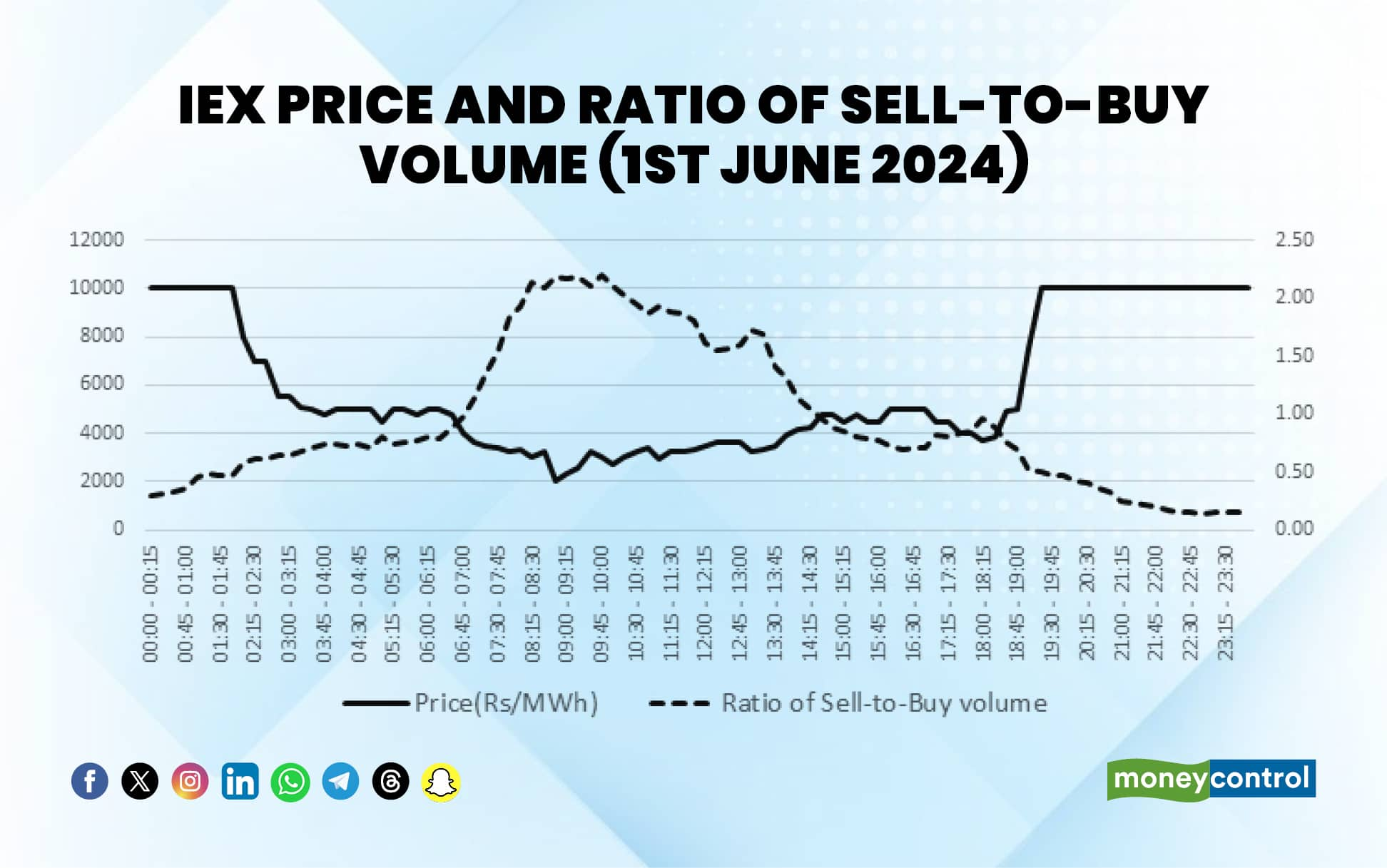



“Duck curve” phenomenon is typical to electricity market. It represents electricity demand and price at different time period during a given day resembling shape of a duck, i.e., higher demand and high price during evening and late night (corresponding to neck of the duck) while lower demand and lower price during midday period (corresponding to the belly) due to increased availability of solar power.
During the day when sunlight is ample, solar power units generate electricity thus creating a greater supply demand mismatch resulting in low price during the day time. The supply demand mismatch even becomes more acute in summer months with availability of plenty of sunlight and more so weekends in summer months with lower industrial activities.
On 1st June 2025, the price of electricity nearly touched zero at IEX (Indian Energy Exchange). The price (Rupees for MWh) for 15-mniutes block during 9:30 am to 3:30 pm hovered around Rs. 99 as compared to peak price of Rs. 4741 around 11:00 pm in the night. Simultaneously, the supply demand mismatch also peaked during the mid-day period.The ratio of sell-to-buy volume hovered around 10 during the mid-day period as compared to less than 1 during the evening and late night. The situation in the real-time market price on the same day is even more precarious –during 11:30 am to 11:45 am, the price stood at Rs 0.34 for MWh. When number of units available for sale is higher than the number of units demanded, the ratio of sell-to-buy volume increases leading to lower prices.


Just to put this discussion in perspective the same analysis has been done for 1st June 2024. Coincidentally 1st June 2024 is also Sunday. As one can see the lowest price was around Rs. 2300/MWh with highest price peaking at Rs.10000/MWh while the sell-to-buy volume ratio remained range bound at 0.16 to 2.
One may ponder why these numbers are so diametrically different just within 1-year, i.e, low price of Rs. 99 vs. Rs. 2300, high price of Rs. 4741 vs. Rs.10000, peak sell-to-buy volume ratio of 2 vs. 12.
In fact, the duck curve has become more pronounced with the belly touching near zero on 1st June 2025 as compared to 1st June 2024. One may argue that just two days of data does not really represent the electricity market, but could these numbers be symptomatic of what is going to be future of Indian electricity market?India has achieved significant growth in renewable energy specifically solar power generation. By February 2025, India has surpassed 100 GW of installed solar power capacity with another 130 GW under implementation and tendering stage. India aiming to achieve 500 GW renewable power generation by 2030. Though this is positive in terms of scaling up India’s renewable energy capacity, would this lead to excess supply during day time leading to low price realisation? In general, would the increasing share of renewable sources in total power supply and higher variability in demand patterns result in higher volatility in electricity prices? Such scenarios call for derivative products in electricity to manage the impact of volatility.
Electricity futures are now available on Indian exchanges, after the market regulator, SEBI, allowed their launch. These are standardized contracts traded on exchanges, allowing participants to buy or sell electricity at a predetermined price for a future date. Unlike physical contracts, electricity futures are financially settled, meaning there is no requirement for actual power delivery. This feature makes them simpler and more accessible to a diverse range of participants. By locking in electricity prices in advance, utilities, industrial consumers, and power producers can protect themselves against sudden price spikes or drops in the spot market for electricity.
This approach can bring predictability to power costs, support better budget planning, and facilitate more informed business decisions. Electricity futures can also enhance price discovery for future periods, providing valuable market signals that guide investments in generation, infrastructure, and procurement strategies.
In India, hedging electricity prices presents several significant advantages, particularly in a market characterized by increasing demand, rising volatility, and a growing reliance on intermittent renewable energy sources. By utilizing electricity futures, stakeholders such as distribution companies (discoms), industries, and renewable energy generators can shield themselves from sharp fluctuations in spot prices. These price spikes often occur due to seasonal demand surges, coal supply issues, or weather-related disruptions.
Hedging promotes better cost predictability, aids in financial planning, protects profit margins, and minimizes the risk of budget overruns. Furthermore, it enhances investment confidence by ensuring revenue stability, especially for renewable projects operating in merchant markets. Overall, hedging contributes to a more stable and efficient power market, aligning well with India's goals for energy security and economic growth.
Though this is welcome step, for the electricity futures market to thrive, a few critical enablers must align.
First, there needs to be greater market awareness among energy-intensive industries, discoms, renewable energy generators about the benefits and mechanisms of electricity futures. Attracting these players to participate in electricity futures market would remain a critical success parameter. Unless liquidity builds up, like any derivative products, these contracts may be prone to manipulation.
Alongside awareness to attract participants, it is essential to develop clear and robust risk management frameworks to address the possibility of counterparty defaults, ensuring trust and stability in the trading ecosystem. Furthermore, improved grid forecasting tools and the availability of real-time data are vital to reducing information asymmetry, enabling informed trading decisions.
(Prabina Rajib serves as director of BIMTECH. Ajit Ranade is a Senior Fellow at Pune International Center.)
Views are personal and do not represent the stand of this publication.Discover the latest Business News, Sensex, and Nifty updates. Obtain Personal Finance insights, tax queries, and expert opinions on Moneycontrol or download the Moneycontrol App to stay updated!
Find the best of Al News in one place, specially curated for you every weekend.
Stay on top of the latest tech trends and biggest startup news.